Located in Portugal, midway between Porto and Lisbon, Coimbra is a captivating city steeped in centuries of history. Visit Roman ruins, medieval architecture, and learn about Coimbra’s academic traditions. Once the capital of the country, Coimbra’s royal and intellectual past is still present today in its historic cathedrals, cobblestone streets, and storied university, one of the oldest in Europe. Today, it’s known not only for its prestigious academic institutions and youthful energy but also for its rich cultural heritage and scenic beauty. Our Coimbra What to See guide includes a 4-day itinerary covering the city’s must-visit landmarks along with nearby gems like Conimbriga’s Roman ruins, Lousã’s traditional Schist villages, and Bussaco Forest’s trails. We’ve also included optional day trips from Coimbra, including hiking trails, beaches, and Knights of Templar castles.
This post may contain affiliate links. If you make a purchase through these links, we will earn a small commission at no additional cost to you. We recommend products we have personally used or verified. Read the full disclosure here.
Don’t have time to read the whole article?
Here is the best Coimbra day tour!
Find the top Coimbra area hotels!
Save this for later!
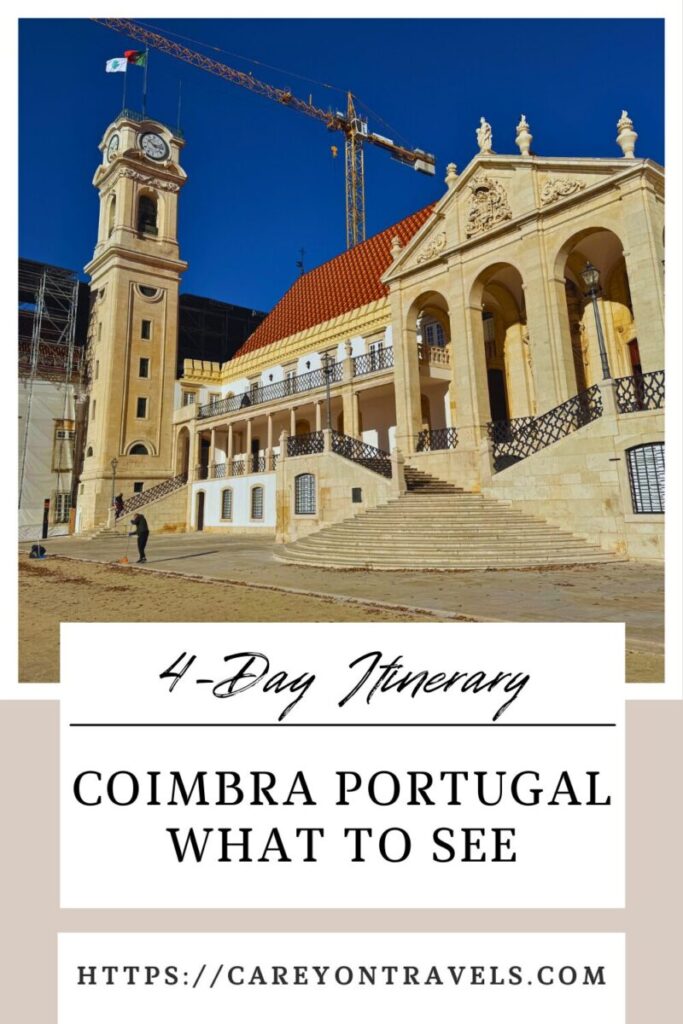
Contents
- Is Coimbra Portugal Worth Visiting?
- Day 1: Coimbra What to See in the City
- Day 2 What to See in Conimbriga
- Day 3 What to See near Coimbra
- Day 4 River Views Before You Go
- Optional Day Trips from Coimbra
- Where to Stay in Coimbra
- Top Tips for Your Coimbra Visit
Is Coimbra Portugal Worth Visiting?
Absolutely—Coimbra is one of Portugal’s most underrated gems. The city has a unique blend of history, culture, and natural beauty that rivals Lisbon and Porto. While many people visit Coimbra as a day trip, we’d recommend spending at least one night if not more. Immerse yourself in the history of this former capital of Portugal, roaming the medieval streets and learning about the key role Coimbra and its university played in the history and identity of Portugal.
Leave time for day trips to unforgettable experiences like the Roman ruins of Conimbriga, Lousã’s traditional Schist villages, and the lush trails of Bussaco Forest. With fewer crowds than Lisbon or Porto, Coimbra offers a more authentic Portuguese experience. After reviewing what to see in Coimbra, we hope you’ll agree that it’s worth spending 2-4+ days here.
What to Read Before You Go to Coimbra
- Hispania The Romans in Spain and Portugal by Michael B Barry – Take a broad look at Roman settlements across Spain and Portugal, providing useful historical background in Portugal’s Roman history.
- The Portuguese A Modern History by Barry Hatton – A readable, modern history of Portugal. This gives essential context for places like Coimbra and its surroundings.
- The Lusiads by Luís de Camões – Portugal’s national epic, filled with mythological and historical references. Though not directly tied to Coimbra, it’s a good cultural touchstone for travelers looking to understand Portugal’s identity.
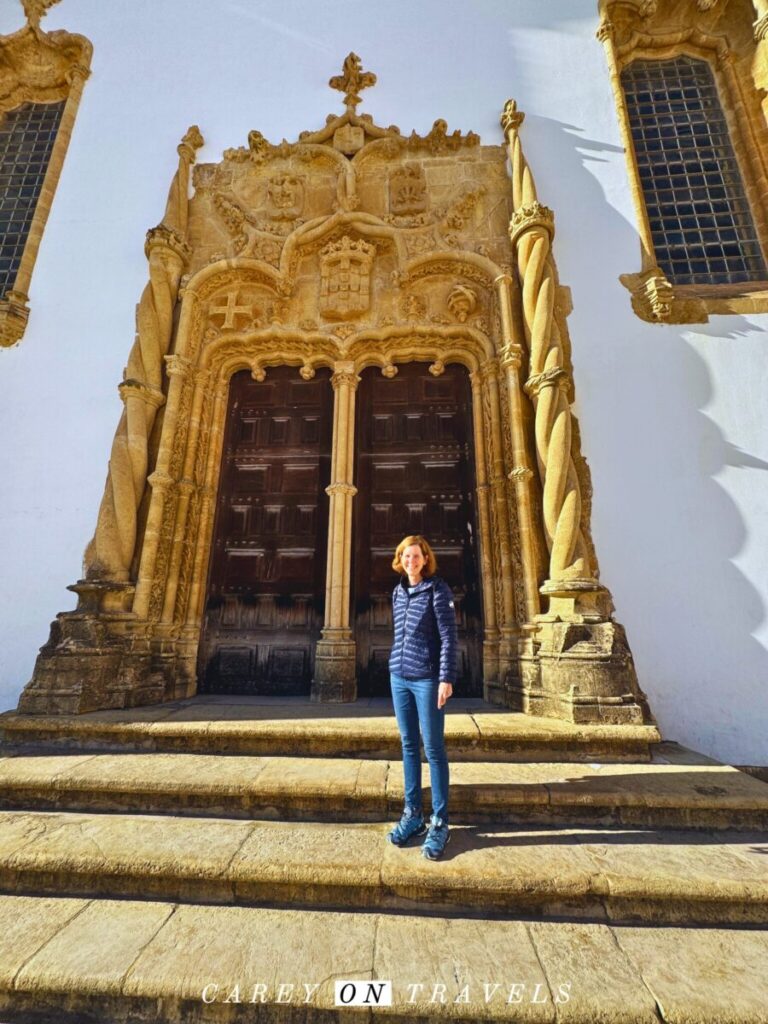
Day 1: Coimbra What to See in the City
Day 1 Morning: Explore the University and the Historic Center
What to see at the University of Coimbra?
- Joanina Library—this 18th-century Baroque library is one of the most beautiful in Europe. Home to over 60,000 volumes dating back to the 16th century, all are housed under gilded wood ceilings and towering bookcases. No photos are allowed within the library.
- Chapel of São Miguel, with its ornate pipe organ.
- Royal Palace of Alcáçova, once a royal residence before becoming the university’s administrative center.
- University Tower, an iconic symbol of Coimbra with panoramic views.
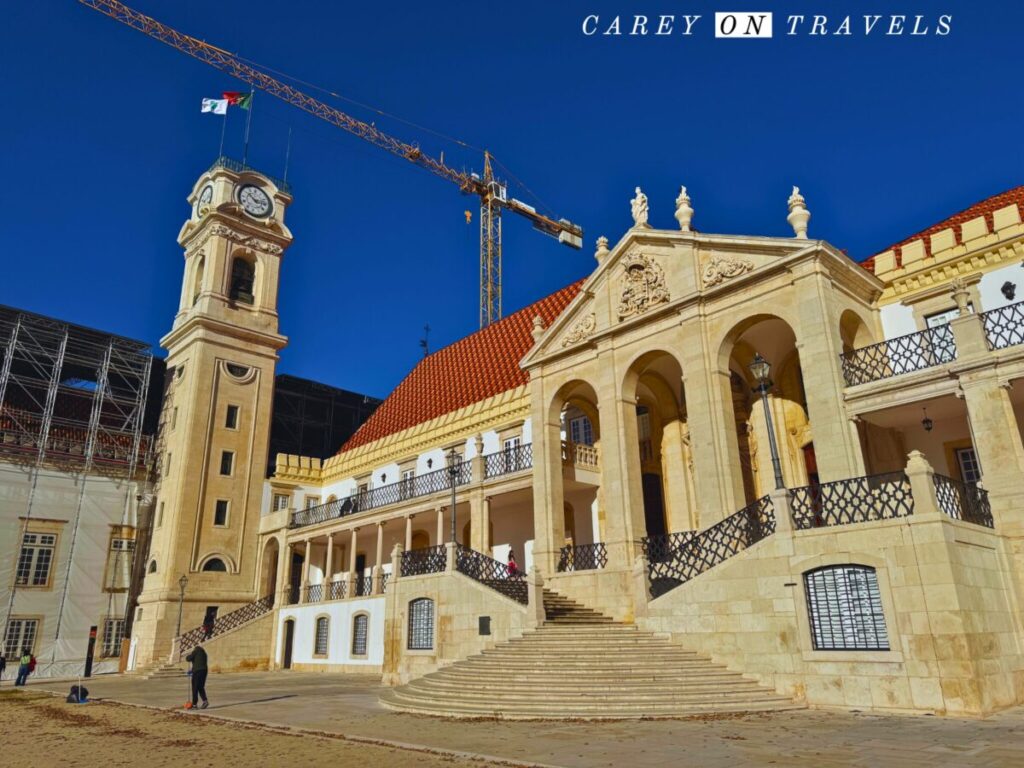
The students dressed in their Harry Potter-esque attire are reminiscent of the similarly attired students in Évora. As it turns out though, this style of dress originated here in Coimbra.
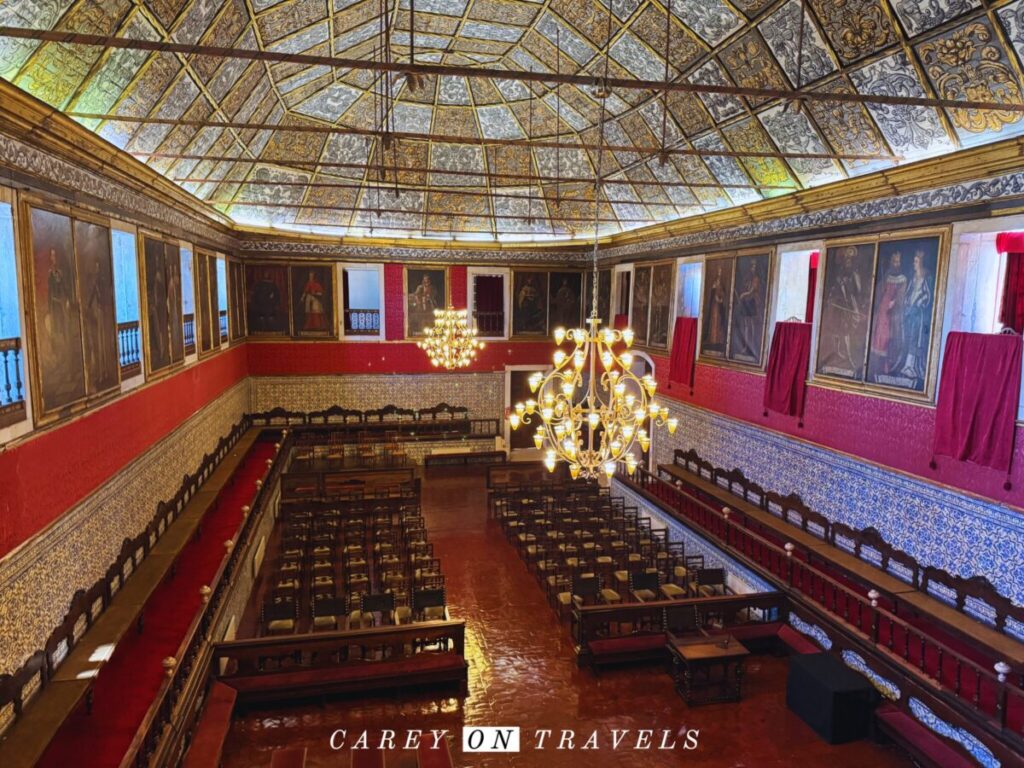
You can walk around the university on your own. That said, we’d strongly recommend taking a walking tour with a current or former student. We enjoyed a wonderful morning exploring the university, and learning more than we could have imagined about the history of Portugal. Check availability of the top University of Coimbra walking tour below:
Stroll Through Coimbra’s Historic Center
This area is best explored on foot. After touring the university, start from the top of the hill at the university and wander your way downhill. As you descend, pass through medieval alleys, Repúblicas (student community houses), and historic quarters. Many of the University of Coimbra tours include this walk.
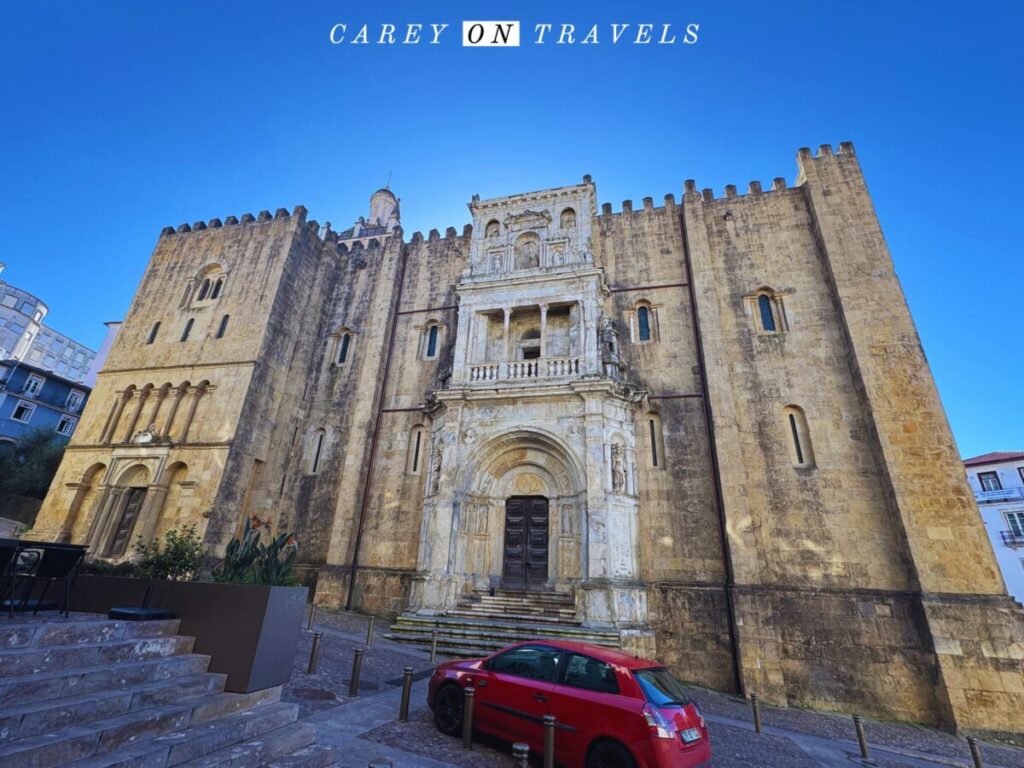
Here are five top sites to see in Coimbra’s historic center:
- Sé Velha (Old Cathedral) – This 12th-century Romanesque cathedral is one of the most important Portuguese examples of medieval architecture.
- Santa Cruz Monastery – Continue your walk down to Praça 8 de Maio, where you’ll find the Santa Cruz Monastery. It’s the final resting place of Portugal’s first two kings, Afonso Henriques and Sancho I. The monastery’s Manueline architecture, azulejos, and cloisters are stunning.
- Sé Nova (New Cathedral) – The Jesuits began construction on the New Cathedral in 1598. It now serves as the city’s main cathedral.
- Rua Visconde da Luz – Stroll along this lively pedestrian street with traditional shops, cafes, and pastry counters.
- Old Jewish Quarter – Detour through the old Jewish district (Judiaria), one of Portugal’s oldest. Look for the discreet signage marking historical points of interest, such as the medieval house pictured below.
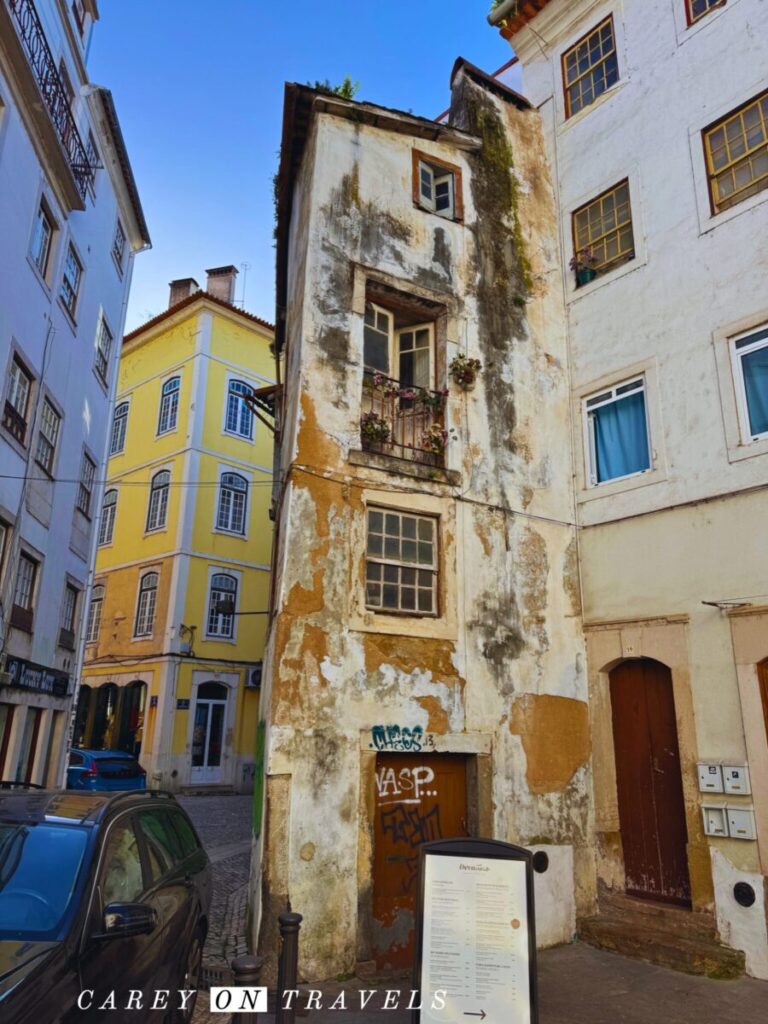
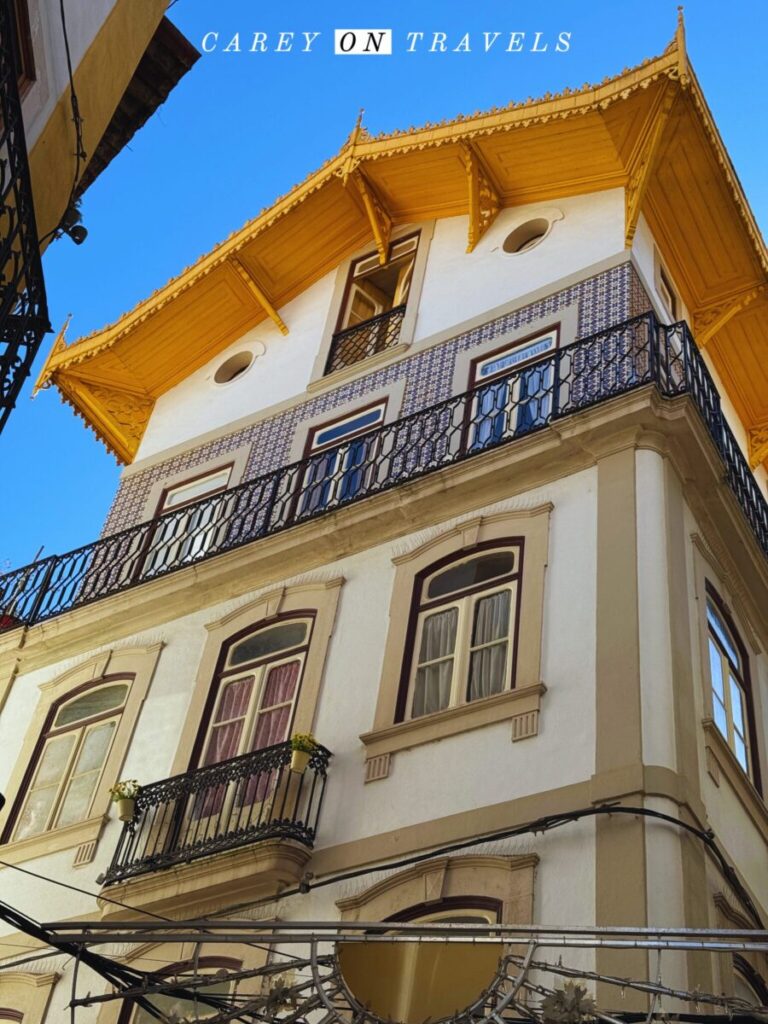
Day 1 Lunch
Enjoy a traditional lunch in the historic center at Sete Restaurante or the cozy and character-filled Zé Manel dos Ossos.
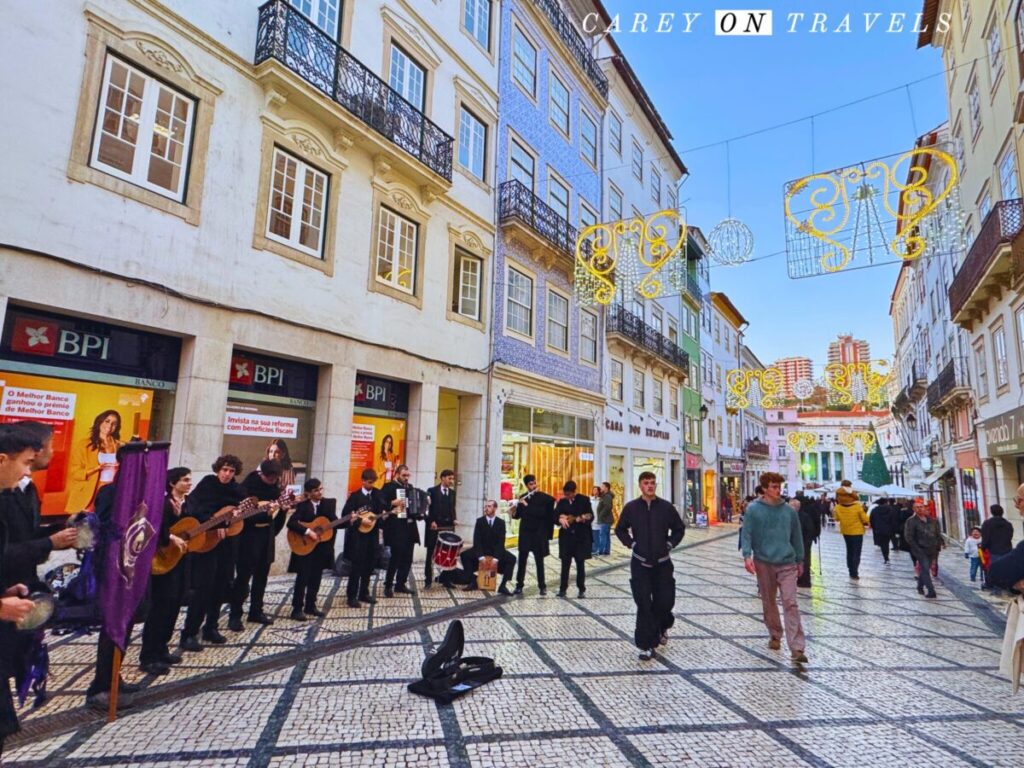
Day 1 Afternoon: Gardens or Museums
Spend your afternoon enjoying one of Coimbra’s most peaceful green spaces or cultural treasures (or both, they are fairly close together).
Wander the Botanical Garden of the University of Coimbra
Tucked just below the university, the Botanical Garden of the University of Coimbra is one of Portugal’s oldest and most beautiful green spaces. Established in 1772 during the Enlightenment reforms of the Marquis of Pombal, the garden was created to support scientific research and medical studies. Here you’ll find an impressive collection of native and exotic plant species, organized into themed areas including medicinal plants, tropical greenhouses, bamboo groves, and rare trees from around the world. Best of all, entry is free, making it an ideal stop for travelers looking for a peaceful, budget-friendly activity.
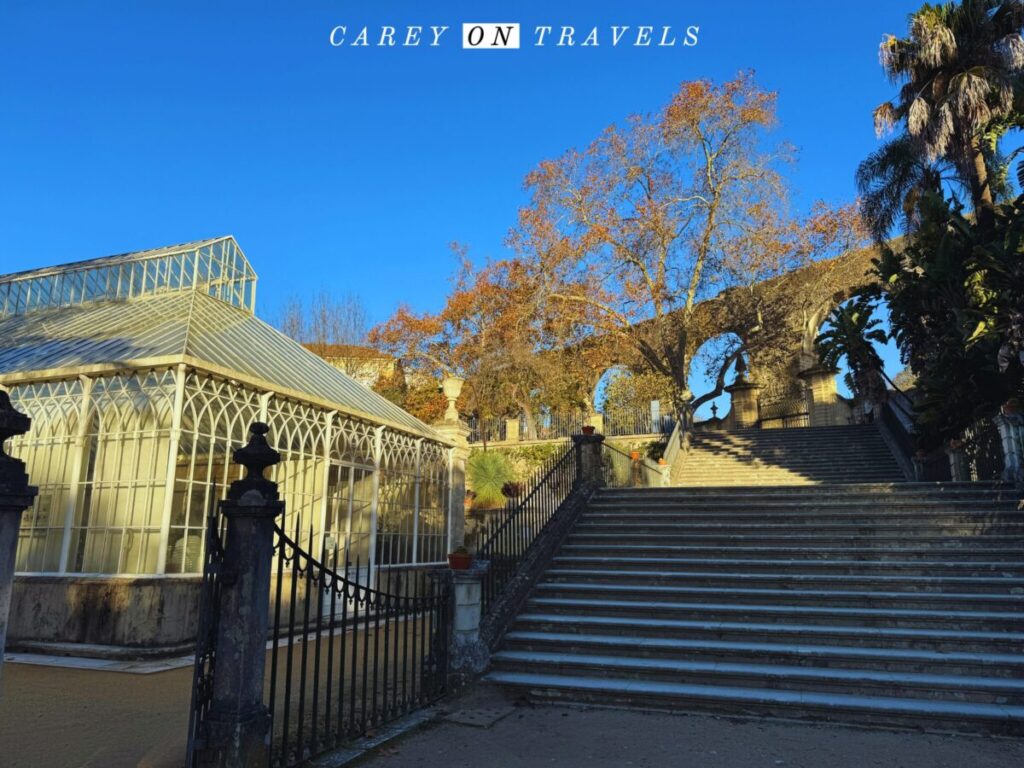
Marvel at the Machado de Castro National Museum
If you’re exploring what to see in Coimbra, the Machado de Castro National Museum is a must-visit for art, history, and Roman ruins all in one stop. Housed in a former Episcopal palace overlooking the city, the museum is considered one of Portugal’s most important cultural institutions. Named after Joaquim Machado de Castro, an 18th-century Portuguese sculptor, it features sculptures, religious art, tapestries, jewelry, and ceramics.
Pro tip: Enjoy a coffee or light lunch on the deck of the museum after your visit to enjoy the views.
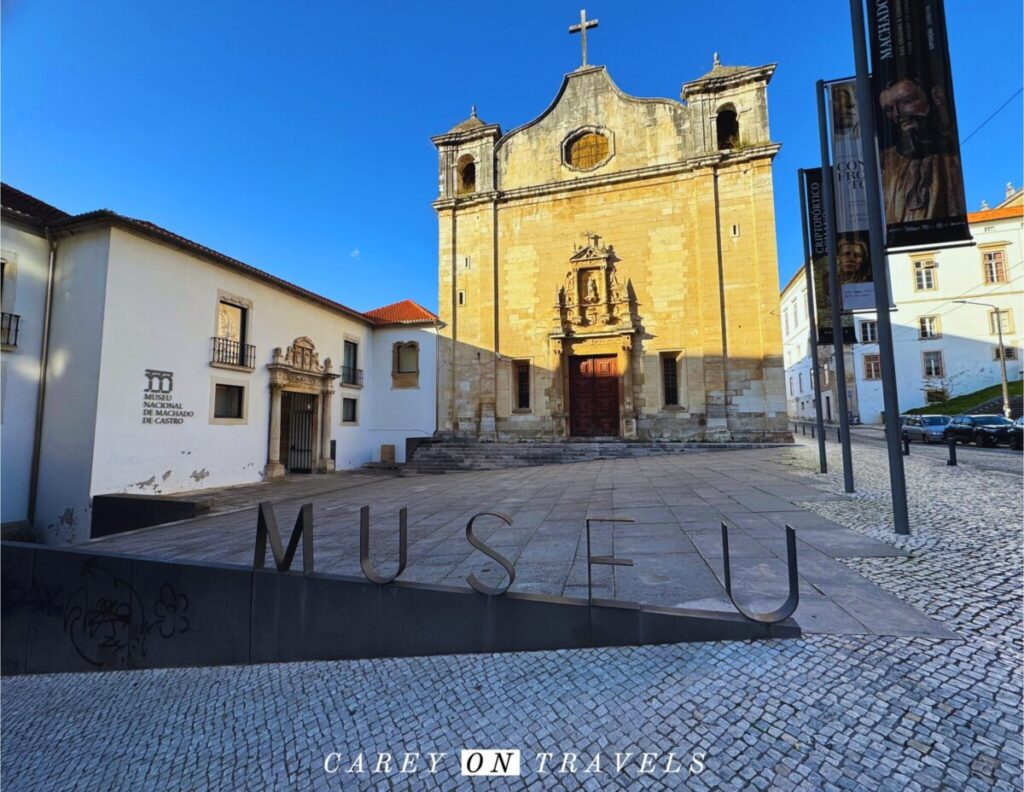
What makes this museum especially unique is the Roman cryptoporticus beneath it. While this adds a few Euros to your entry ticket, we’d highly recommend it. You’ll find an underground network of arched galleries that once formed the foundation of the ancient Roman forum.
Pro tip: Be sure to follow to signs, it’s a bit easy to get turned around in the dimly lit tunnels.
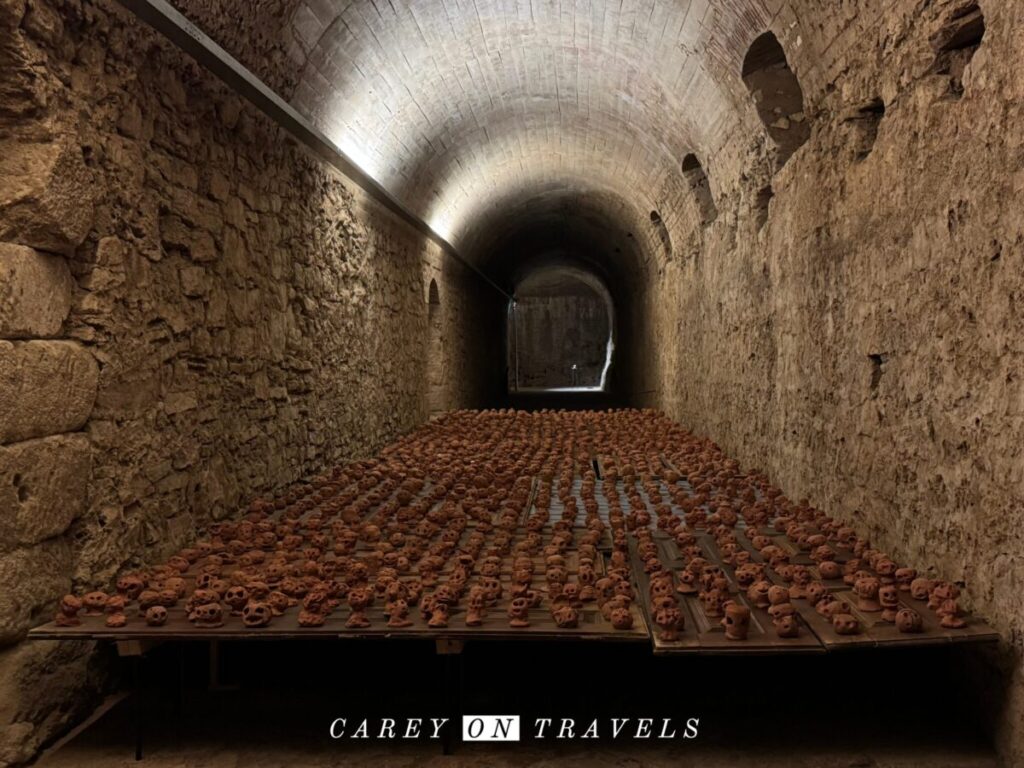
Day 1 Evening: Fado de Coimbra
Fado de Coimbra is different from the form of Fado seen in Lisbon and other parts of the country. Unlike the more widely known Lisbon style of fado, Coimbra’s version is performed exclusively by men, traditionally university students or alumni, dressed in the signature black academic robes. The songs are poetic and often touch on themes of love, saudade (longing), and the passage of time.
For a truly special experience, attend an evening concert at Fado ao Centro, located in the historic center. Each performance includes a brief introduction to the tradition, followed by a beautifully curated live show. If you’re looking for a more casual setting, don’t miss the free daily fado concerts at Café Santa Cruz, usually held around 6 and 10 p.m. beside the Santa Cruz Monastery. For those who’d like to pair a wine tasting with a Fado concert, this tour may be a great option.
You can enjoy this Fado evening on any day of your trip.
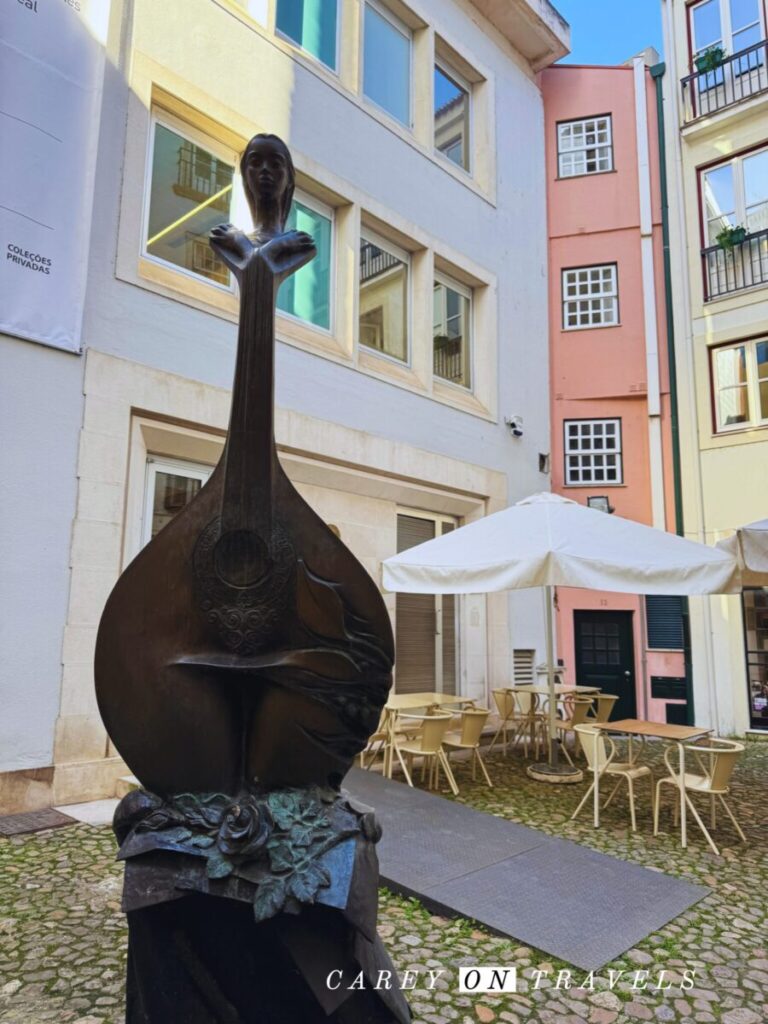
Day 2 What to See in Conimbriga
Day 2 Morning & Afternoon: Conimbriga Roman Ruins
The next stop in our Coimbra What to See Guide is a bit outside of the city, the Conimbriga Roman Ruins. Just 15 km south of Coimbra near Condeixa-a-Nova, Conimbriga was one of the largest and most prosperous Roman settlements in what is now Portugal. The Romans inhabited Conimbriga from the 9th century BC and flourished between the 1st and 3rd centuries AD. Before exploring the ruins, start at the on-site Conimbriga Monographic Museum. It adds valuable context with displays of recovered artifacts, including pottery, coins, tools, and sculptures.
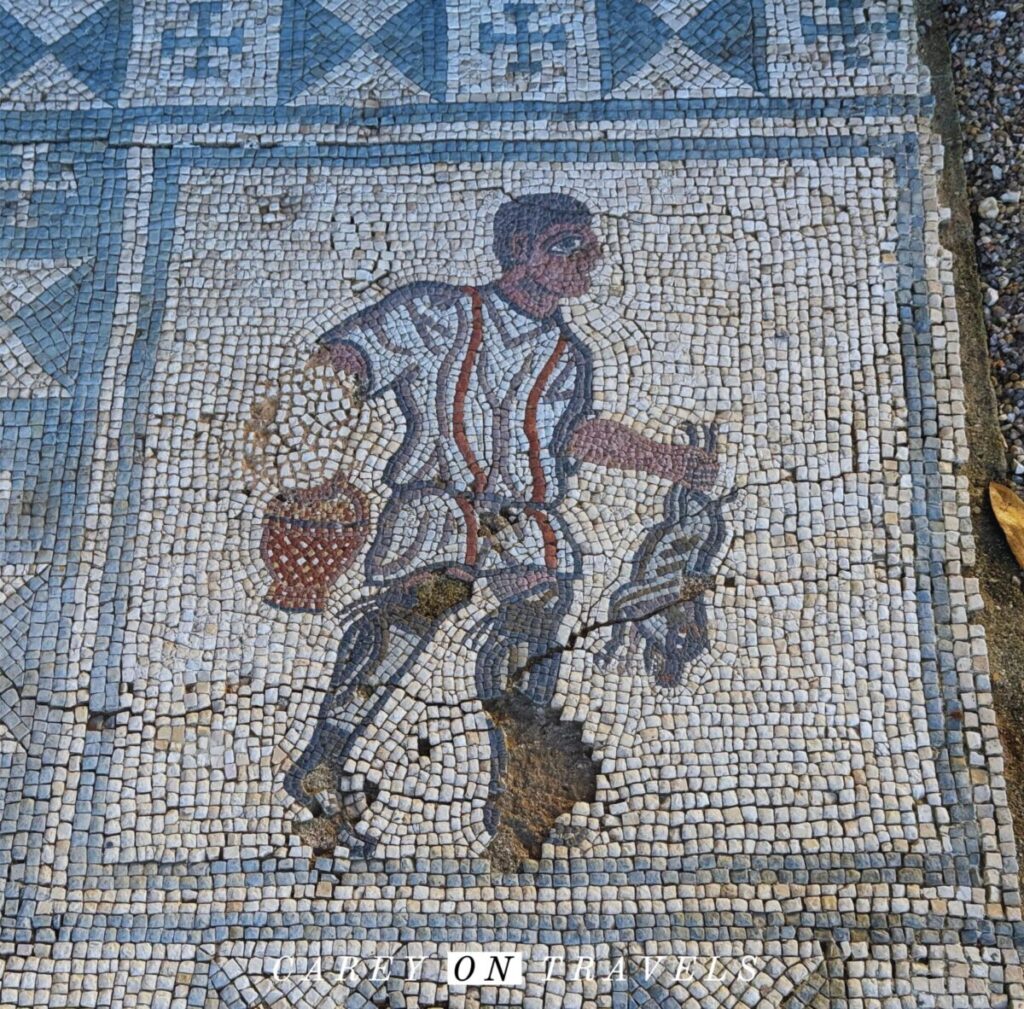
What makes Conimbriga so captivating is its exceptional state of preservation. Walk through the extensive ruins and see the remains of Roman houses, baths, an amphitheater, aqueducts, and city walls. The intricate mosaics, especially in the Casa dos Repuxos (House of the Fountains), are incredible. Wander around the Roman forum and public buildings to get a glimpse into daily life.
Conimbriga is an essential stop and is one of our favorite Roman Ruins in Europe. Aim to visit in the morning to avoid the heat and crowds, and allow at least a couple of hours to wander around this extraordinary site. To make the most of your visit, we’d recommend taking a small group or private tour. There are interpretive signs, but the tour guides are tell a much better story of life in Conimbriga.
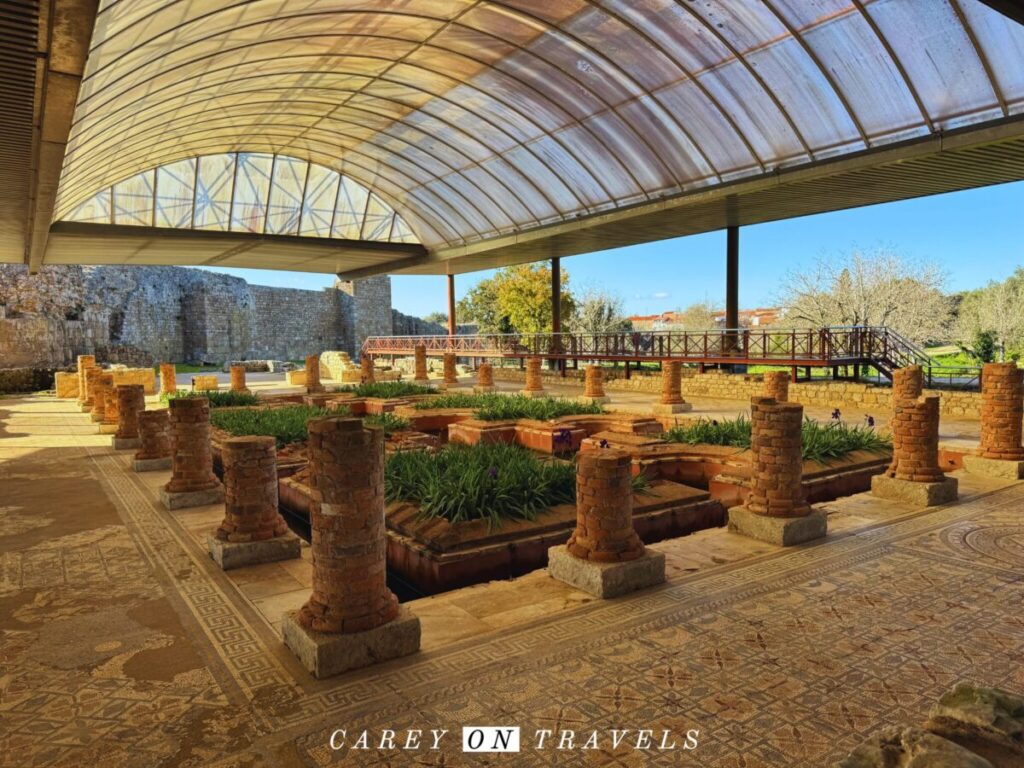
Day 2 Evening: Dinner & Local Cuisine
No visit to Coimbra is complete without diving into its rich and flavorful cuisine, which blends traditional Portuguese dishes with local specialties. One of the local favorites is chanfana, a hearty stew of goat or lamb slow-cooked in red wine and garlic. You’ll also find plenty of fresh river fish, creamy rice dishes, and regional cheeses. For something sweet? Don’t leave without trying pastéis de Santa Clara, a rich pastry filled with sweet egg yolk and almond cream, created by nuns in Coimbra’s convents. We’d recommending having this with a cup of coffee at Pastelaria Briosa. Or, enjoy a Suspiro, a large egg-white meringue.
Pro tip: If you have extra time before dinner, enjoy exploring the historic center of town, or take a walk along the Mondego River. You’ll find many river-side restaurants where you can enjoy a drink overlooking the water.
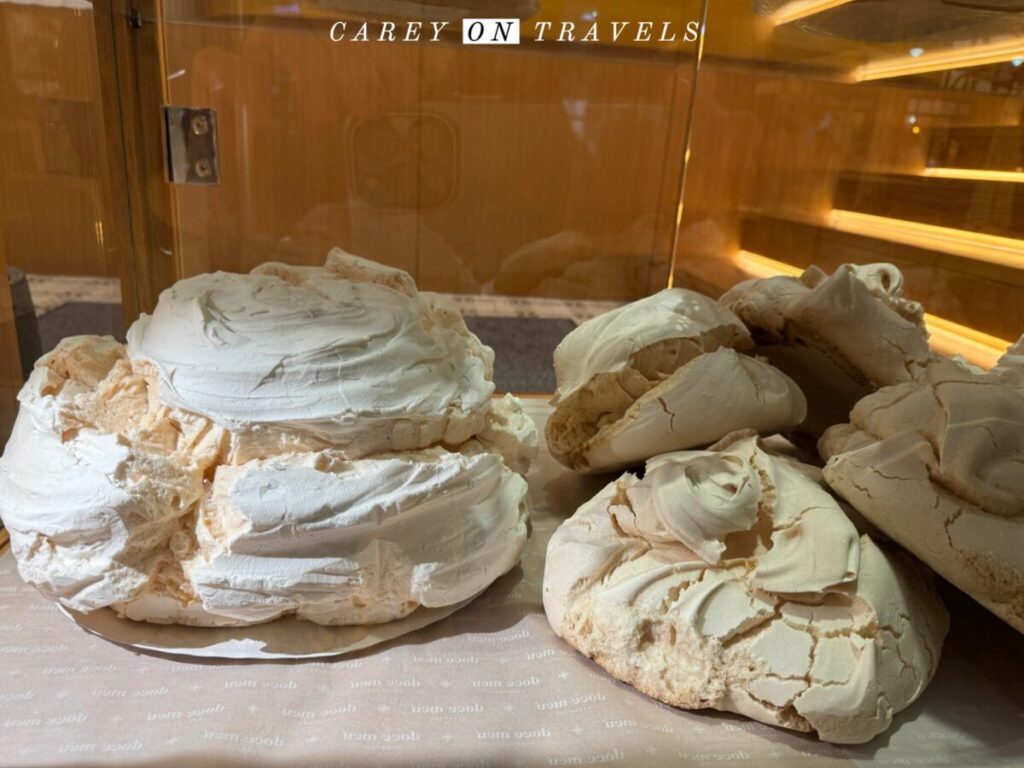
A few great restaurant options are:
- Loggia has wonderful views and seasonal menus (attached to the museum).
- Zé Manel dos Ossos is a local institution beloved for its rustic charm and hearty portions of traditional foods (expect lines).
- Sete Restaurante offers a more contemporary dining experience in the heart of the old town.
- Café Santa Cruz—set inside a beautifully restored former church—offers pastries and light meals in an atmospheric setting (and free Fado in the evenings).

Day 3: What to See near Coimbra
For day 3, we’ve include a few options, exploring the Schist Villages or the Bussaco Forest and Palace. If you are ambitious, and don’t mind a full day, you could do one in the morning, with the other in the afternoon.
Option 1: Tour the Schist Villages of Lousã
For those seeking a more rural escape, a visit to the schist villages of Lousã is a must. These traditional villages were built almost entirely from local schist stone (mudstone / shale). They’re tucked into the slopes of the Serra da Lousã mountains, about an hour from Coimbra. Once vibrant agricultural communities, most of these villages were gradually abandoned during the 20th century as younger generations moved to urban centers in search of work. By the late 1900s, most had fallen into disrepair.
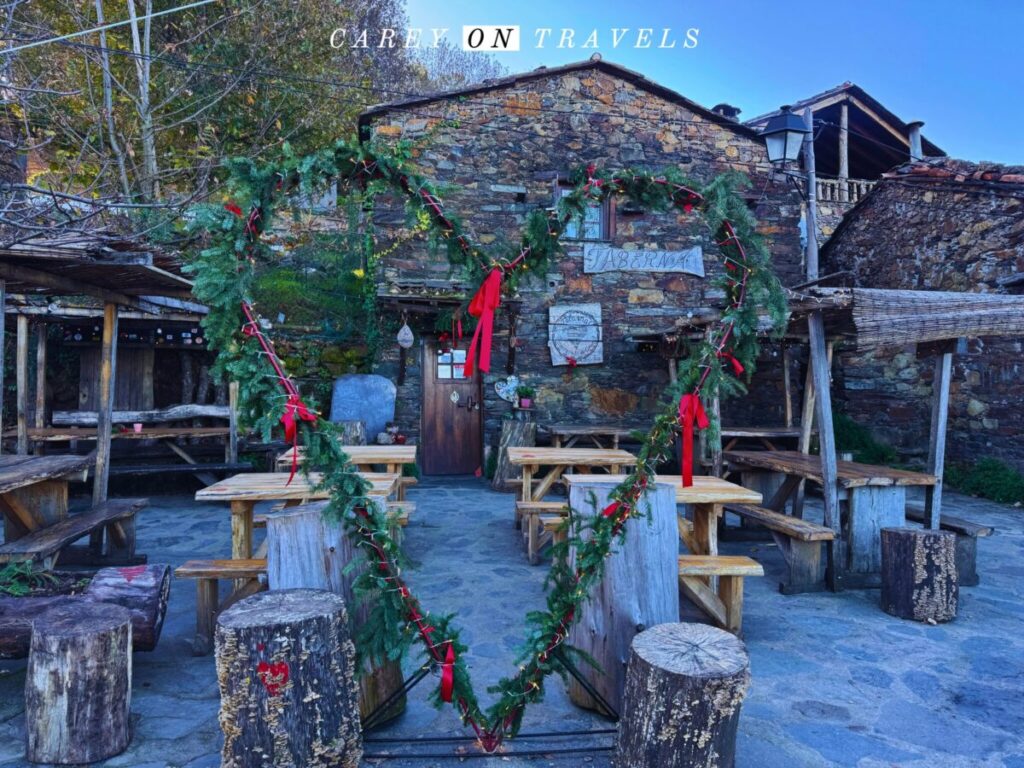
In recent decades, villages such as Talasnal, Candal, and Cerdeira have been carefully restored through government-backed initiatives and passionate local efforts. Their historic charm has been preserved, while introducing small-scale tourism and vacation rentals. Cerdeira also hosts a unique artist workshop.
Today, they’re peaceful retreats where visitors can explore narrow stone alleys, panoramic hiking trails, and family-run taverns and cafés. To fully appreciate the history and hidden gems of the area, we’d highly recommend taking a guided tour from Coimbra. Some of the villages are only reached via narrow, windy, mountain roads, so it’s nice to let someone else do the driving. Search for the ideal tour for you below:
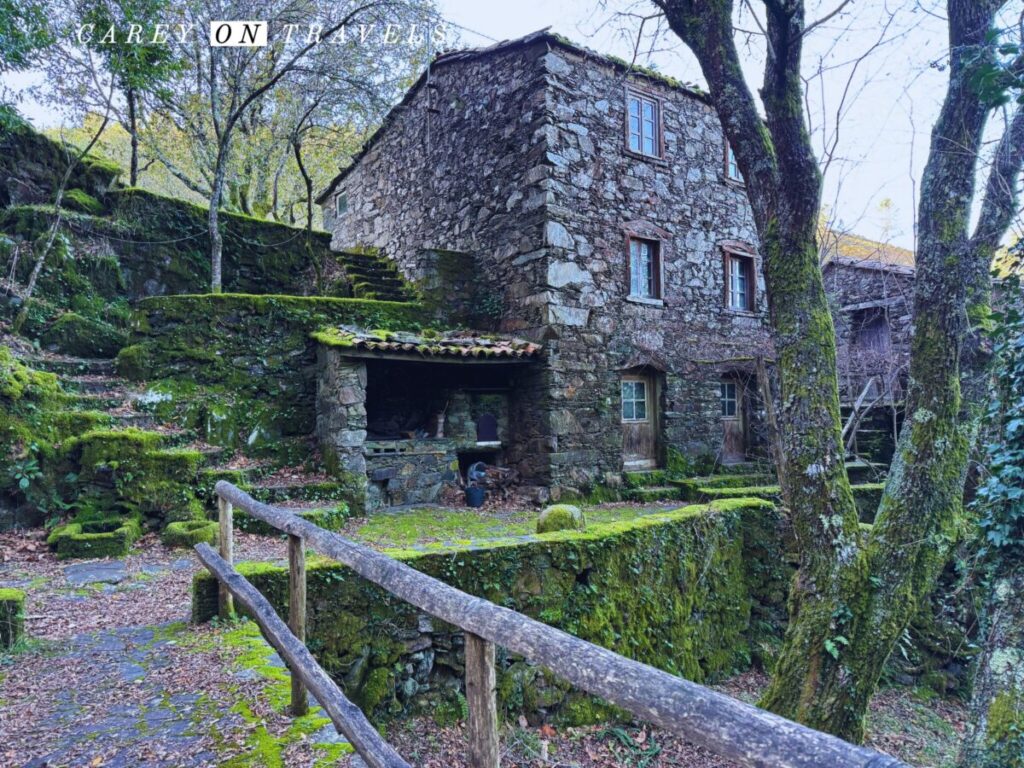
Option 2: Bussaco Forest and Palace
The Mata Nacional do Bussaco (Bussaco Forest) is just 30 minutes from Coimbra. Once a monastic retreat for Discalced Carmelite monks in the 17th century, the forest was carefully cultivated as a spiritual and ecological haven. Today, it is a protected landscape with centuries-old cypresses, cedars, and exotic specimens from around the world. As you wander its trails, you’ll come across quiet hermitages, chapels, fountains, and viewpoints, many of which were constructed by the monks for meditation and solitude.
At the heart of the forest stands the late 19th century Neo-Manueline Palace Hotel do Bussaco, one of Portugal’s most iconic architectural landmarks. Today, it’s a luxury hotel, where you can sleep in rooms once reserved for royalty. Even if you’re not staying overnight, the palace and its surrounding grounds are well worth a visit for a drink on the terrace or a leisurely lunch in the elegant dining room.
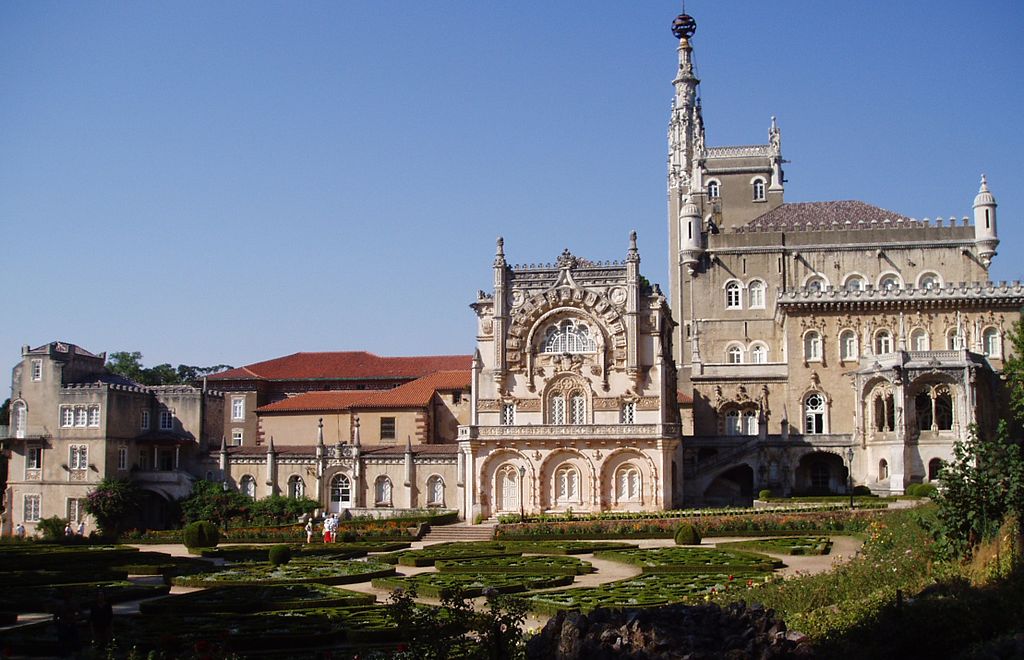
Day 4: River Views Before You Go
Morning: Mondego River Cruise or Kayak Tour
Before departing, enjoy a final look at Coimbra from the water with a Mondego River traditional Barca Serrana cruise or guided kayak tour. These short trips offer peaceful views of the city skyline, the Pedro e Inês footbridge, and surrounding landscapes.
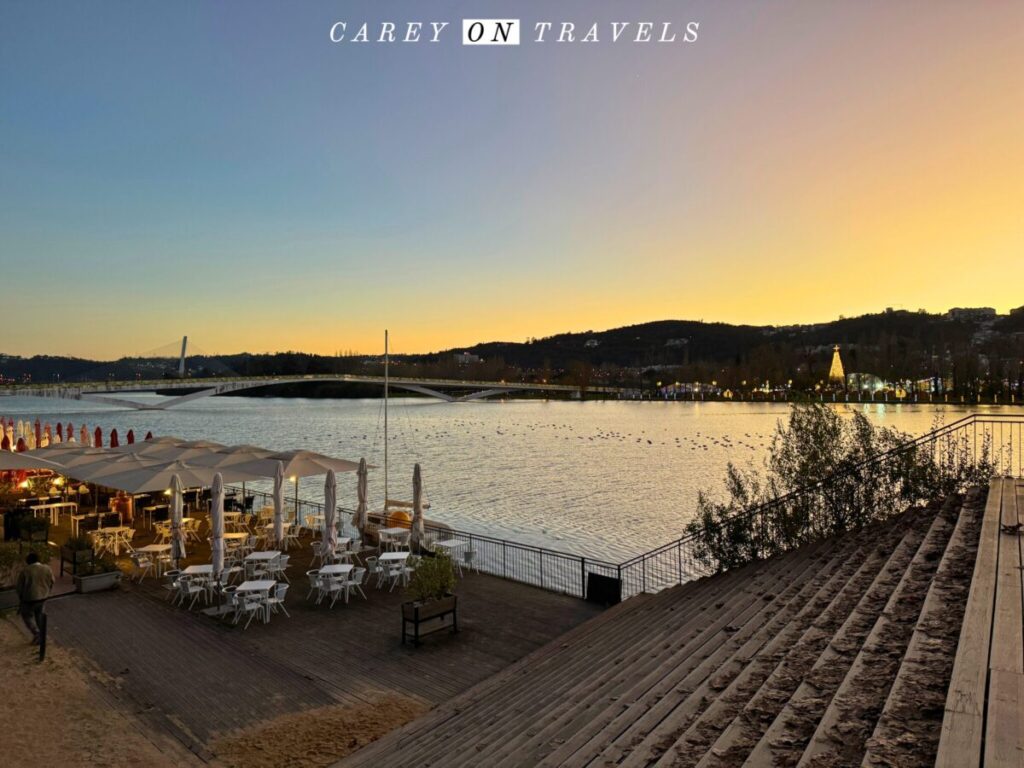
Check availability of the top kayak tour below:
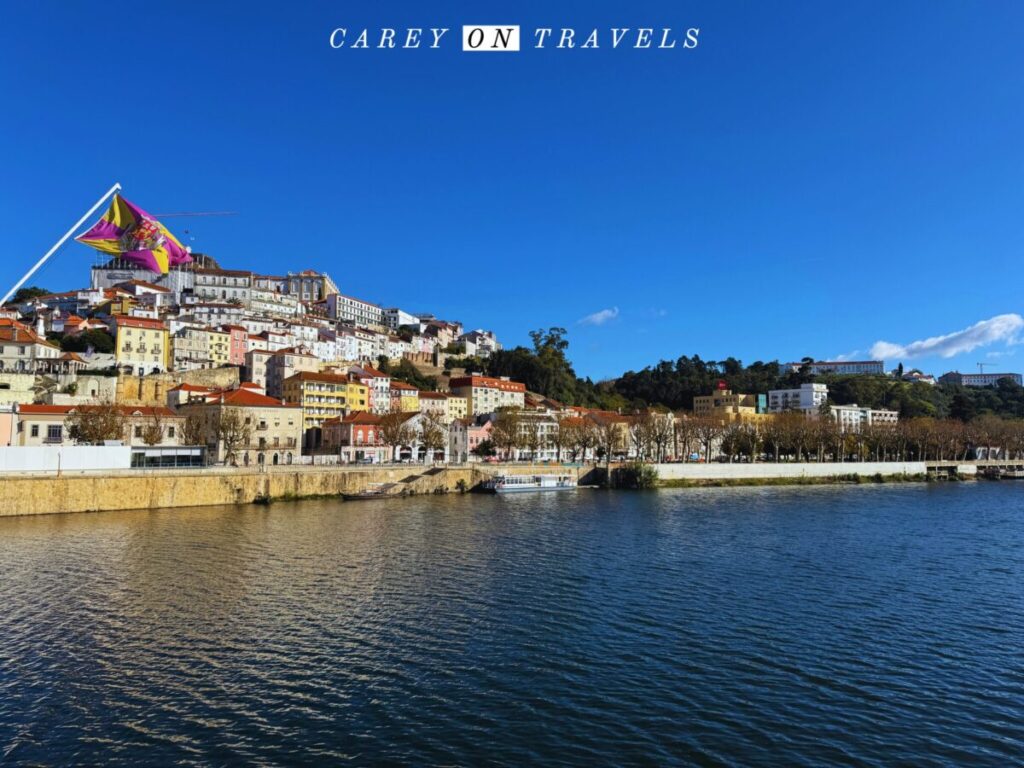
Optional Day Trips from Coimbra
You could easily spend a week or more in Coimbra by adding these fantastic day trips:
- Tomar & Almourol Castle – Explore the Knights of Templar heritage of Tomar and visit the fairytale Almourol Castle on an island in the Tagus River
- Nazaré & Batalha Monastery – Enjoy seaside views and giant waves in Nazaré, followed by a visit to the impressive Gothic monastery in Batalha.
- Aveiro – Often called the “Venice of Portugal,” Aveiro offers colorful canals, art nouveau buildings, and delicious ovos moles pastries.
- Paiva Walkways (Passadiços do Paiva) – Hike one of Portugal’s most stunning wooden boardwalk trails along the Paiva River, a full-day adventure for nature lovers.
- Porto – Just over an hour by train, Porto makes for a dynamic day trip full of culture, food, and riverside beauty. Stroll along the Ribeira, visit a Port wine cellar, and visit the nearby stunning beaches. Porto also makes a wonderful base for further day trips in Northern Portugal.
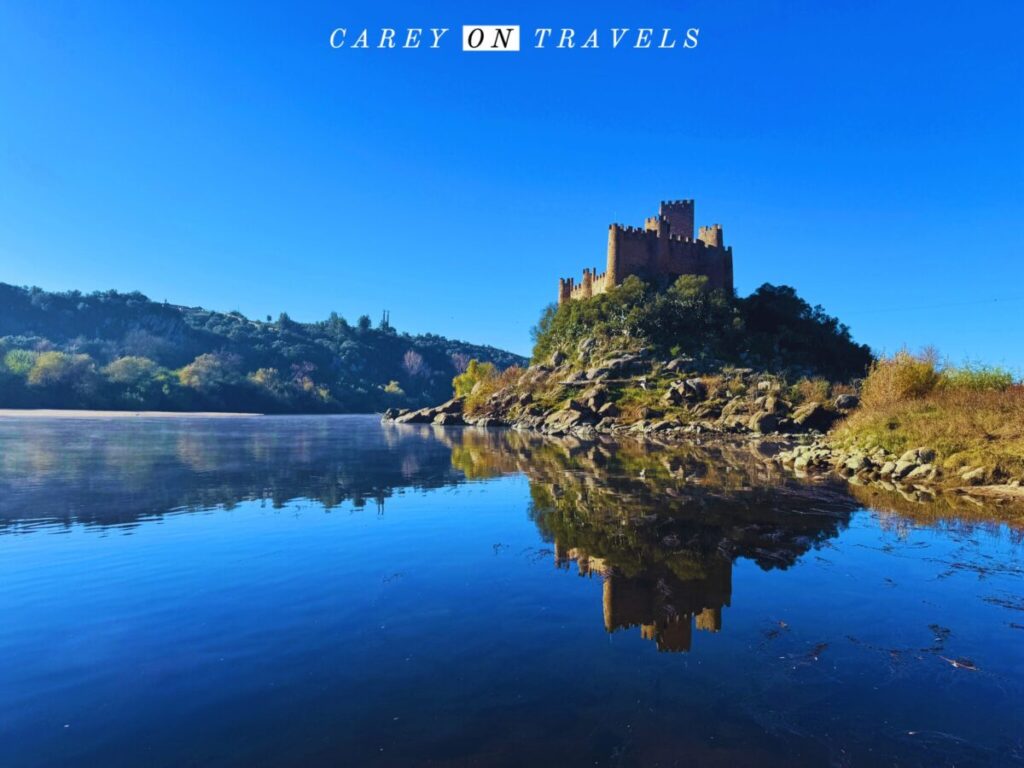
Where to Stay in Coimbra
For an unforgettable stay in Coimbra, base yourself in the heart of the historic center at the Sapientia Boutique Hotel. This stylish and sustainable property is located right next to the University of Coimbra. In addition to the incredible location just steps from the Joanina Library, the sunsets over the river from the rooftop and its warm hospitality are incredible. Both rooms and studios with kitchenettes are available. See our full review of Sapientia Boutique Hotel for more information.
A few other excellent options nearby include the elegant Solar Antigo Luxury Coimbra, known for its beautifully restored stone interiors, and Hotel Quinta das Lágrimas, a romantic retreat set in lush gardens just across the river from town. For budget-conscious travelers, Serenata Hotel & Hostel Coimbra offers great value with modern amenities and a prime location. Search for other lodging options on the map below:
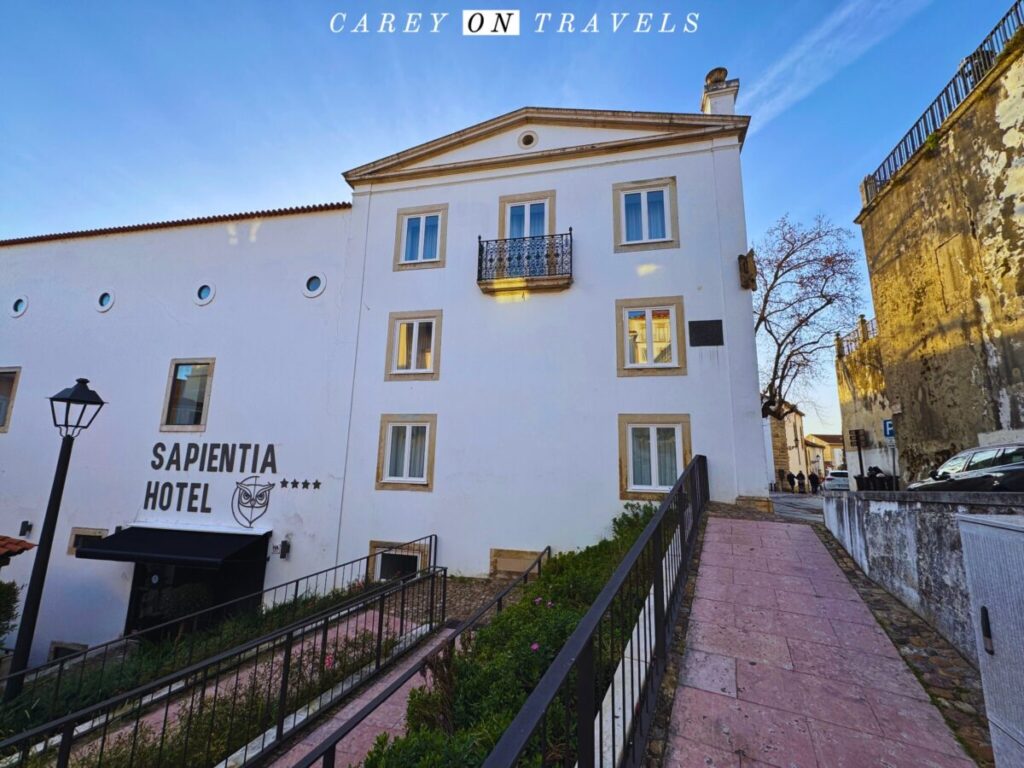
Tips for your Coimbra Visit
- Getting Around: Coimbra’s historic center is best explored on foot. Taxis are available if you’d like a ride up the hill to the university. The streets are very narrow–we’d recommend against driving your car around the old town streets. For trips to Conimbriga, Lousã, and Bussaco, we’d recommend joining a guided tour. If you decide to rent a car, read our tips for renting a car in Portugal to ensure a stress free rental experience. We use and recommend Discover Cars for our Portuguese car rentals.
- When to Go: Spring and early autumn are ideal for pleasant weather and fewer crowds. Winter has very few tourists, but be aware of the cooler weather (there was even some ice when I visited the Schist Villages nearby in winter).
Coimbra What to See Guide Wrap-Up
Coimbra is a destination that seamlessly combines history, culture, and natural beauty, and is often overlooked for those visiting Lisbon and Porto. A visit to Coimbra is an unforgettable experience, whether you’re delving into its Roman past, immersing yourself in university traditions, or enjoying walks along the Mondego River.
New! Take the Quiz: What’s the Best City in Portugal for You?
Not sure where to start? Take our quick quiz to find your perfect match based on your travel interests, pace, and vibe.
👉 Take the quiz here What’s the Best City in Portugal for You? or directly below:
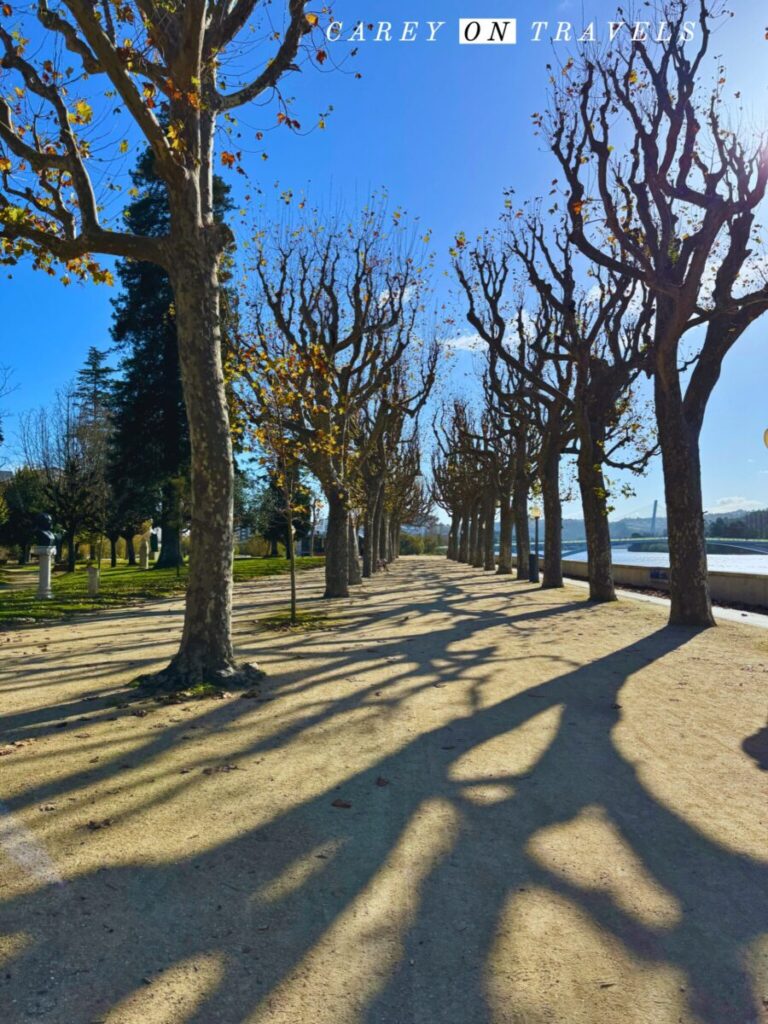
You Might Also Enjoy:
- Best Destinations in Portugal in Winter
- Lisbon to Coimbra Road Trip.
- Knights Templar Portugal, Tomar Day Trip
- The Best Cities in Portugal, Which One Should You Visit?
- Conimbriga Roman Ruins Portugal
- Portugal Schist Villages
- Top Tips for Renting a Car in Portugal
- 10 Activities in Lisbon Off-the-Beaten Path
- Queluz National Palace
- Top 10 Activities in Sintra Off-the-Beaten Path
- Top 16 Day Trips from Porto Portugal
- 12 Tips for Visiting the Paiva Walkways
- Things to Do in Guimarães, the Birthplace of Portugal
- Top Things to Do in Ponte da Lima, Portugal’s Oldest Village
- Best Unique Places to Stay in Évora
- What to See in Évora, Portugal, a Traveler’s Guide
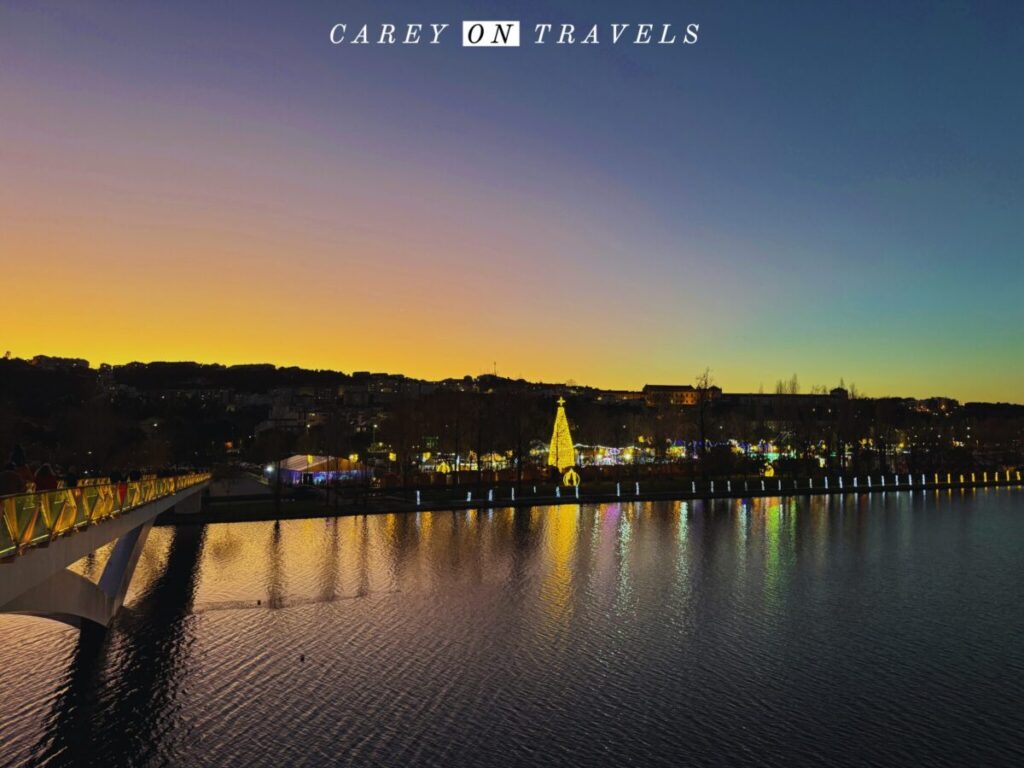
If you enjoyed this post, pin it for later!

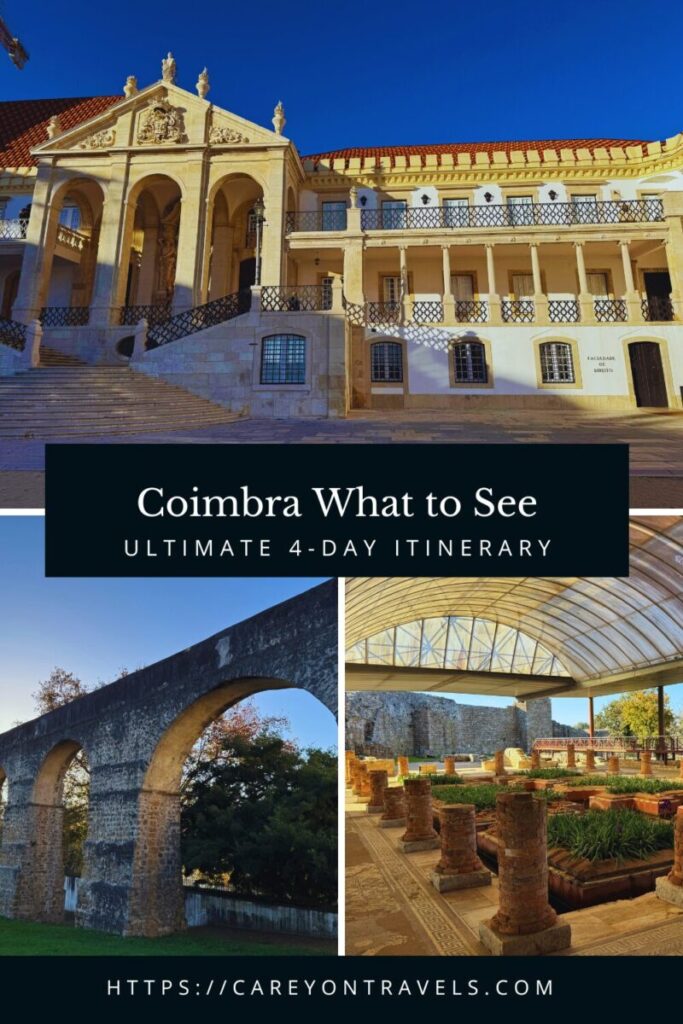
Travel Resources
We recommend booking through our preferred travel booking sites below.
| Air Travel | SkyScanner |
| Lodging | Booking.com, VRBO.com, Expedia.com, Hostelworld |
| Tours and Activities | Viator.com, GetYourGuide.com, TakeWalks.com |
| Car rentals | Discovercars.com |
| Travel insurance | Squaremouth |
| Bike and scooter rentals | BikeBookings.com |
| Train tickets | Trainline, RailEurope |
| Bus tickets | Flixbus, Busbud |

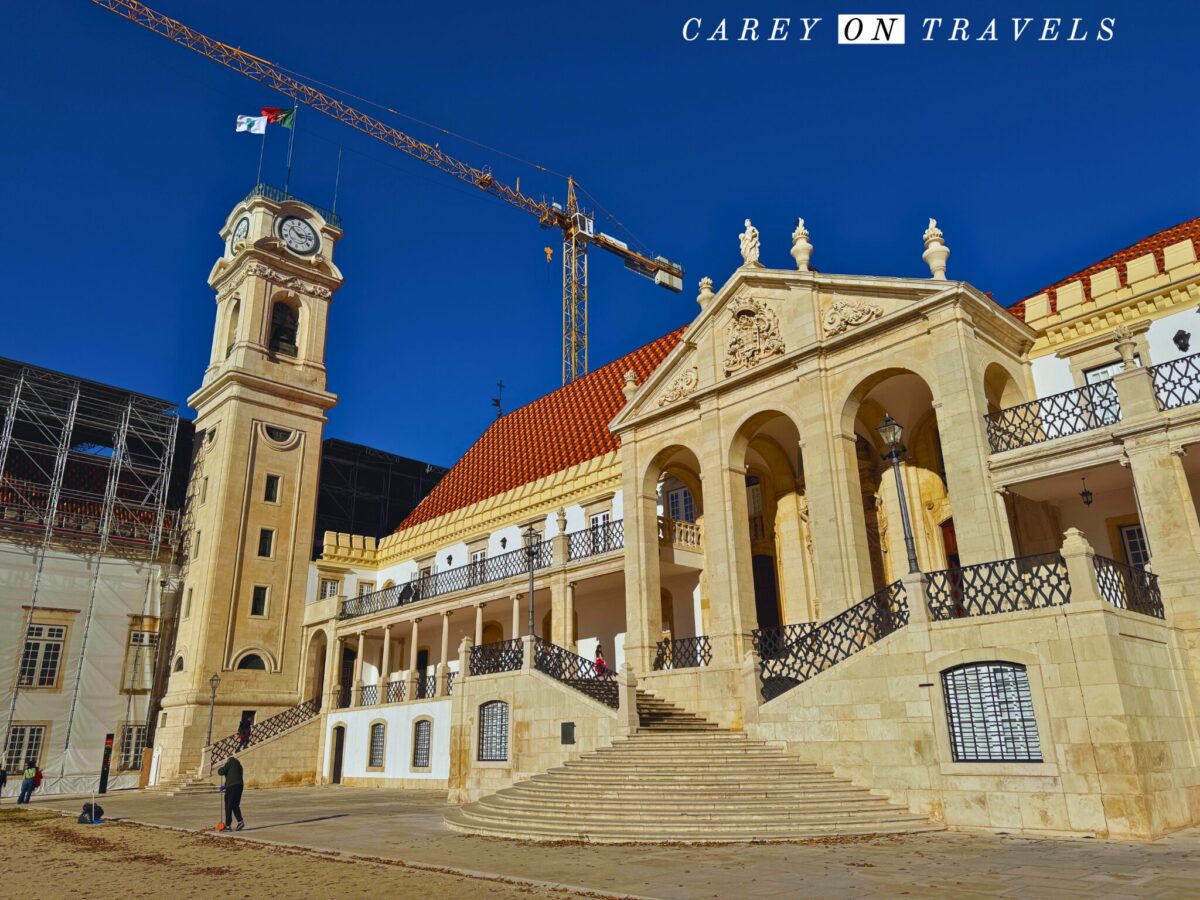



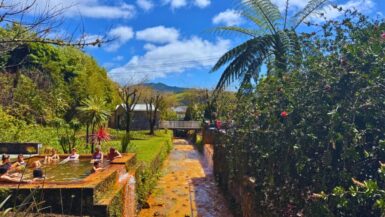

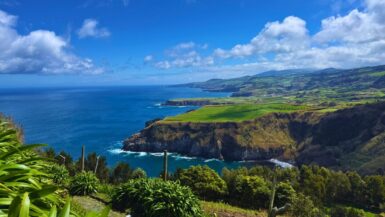
[…] best way to experience it in a short amount of time. I did just that on a recent solo day trip from Coimbra. Come along on a private 4×4 day tour from Coimbra to experience and learn about the history […]
Sounds like an interesting town! Portugal is one of the destinations I’m definitely going back to, so I’ll keep Coimbra in mind.
Hope you are able to visit Coimbra!
You just convinced me to add Coimbra to my Portugal road trip itinerary! Thank you for sharing all of those infos!
Hope you enjoy it!
I’ve recently been investigating Portugal as a potential travel destination so this post is just further fueling that desire to visit. the Roman history, and of course the food, make me think Coimbra needs to be part of the in itinerary
Lisbon & Porto are wonderful, but Coimbra (and Évora as well) to me have a more authentic experience. Visiting the bigger cities and these smaller cities would be ideal for a first visit.
What a wonderful-sounding town! It surely is worth a few days (at least)!
One question, please: Isn’t there any type of local/public transportation to the neighboring towns and other attractions?
It depends on which towns. You can reach Tomar by train, where you can visit the Convent of Christ. You can also reach the Buçaco Palace by bus, though the forest is fairly extensive to explore on foot. You can take a bus to Lousã as well, where you could hike up to the castle in 20-30 minutes, and you could continue on to the Schist Villages. These are fairly spread out though, so your visits may be a bit limited. There is a sporadic bus (just 3 times/day) to Conimbriga.
Definitely need to add this to my list…it looks beautiful. We have beeb to Portugal twice but missed this town. I’m hoping to go back for a winter visit soon. Thanks for the tips.
Coimbra and Évora (in the Alentejo) are both great choices for smaller university cities with tons of history and culture if you’re looking to add to your itinerary.
I must visit this city on my next trip to Portugal. I loved your photos.
Thank you, Coimbra is definitely worth a visit.
I’ve always wanted to see the Joanina Library! Coimbra sounds like the ideal spot for the traveler who wants to avoid some of the tourist crowds. I hope it stays that way until I get there. So many amazing things to see and do.
Visiting in winter is a wonderful way to avoid the crowds. It can be rainy, though on our recent visit it was beautifully sunny (though chilly). I’d strongly recommend taking a tour for the Joanina Library (it is beautiful in its own right, but learning about the history makes it much more meaningful).
Exploring the Schist villages sounds like such a wonderful experience — I’d absolutely love doing that. Wandering through their narrow stone alleys, soaking in the rustic charm, and discovering the rich history and local traditions would be such a delight.
If you have the time, I’d consider spending a night or two in one of the villages. I didn’t have a chance to do that on this last trip, but hope to in the future.
[…] seconds agoAdd comment Share this article PinterestFacebookRedditEmail Next article Coimbra What to See: A 4-Day Itinerary Home » Blog » Places to Stay » Sapientia Boutique Hotel Coimbra […]
We once did a one-thousand-point turn to extract our car from their narrow streets. Harrowing but glad I got to explore this lovely town!
Very glad I didn’t have to do that. Staying at Sapientia (just under the university), they had us cut through a parking lot to avoid the narrow streets.
Coimbra sounds like a great place to stop by while in Portugal. Roman ruins, history and architecture abound many of the places in Portugal as well as Spain. The image of Almourol castle looks very impressive. 🙂
Almourol is well worth a visit. I had the island all to myself for my visit (it was in December), which was amazing.
Coimbra looks like a wonderful place to soak up the history, architecture and culture, of Portugal’s original capital. Something I have learnt reading your post and certainly a place that I would love to experience.
I learned more about Portuguese history in Coimbra during my university tour than I had gotten in many years of visiting the country. Quite amazing experience!
I was not familiar with Coimbra before reading your post, and I am so glad I read this. What a fantastic place- I love that much of it has been restored to represent its original charm. Also, those sunsets- WOW!
Hope you have a chance to visit Coimbra. It is truly charming, and so much history and culture to explore.
Coimbra looks like such a beautiful and historic city! I’d love to explore its old streets and visit the famous university. Thanks for the great recommendations!
Hope you’re able to visit!